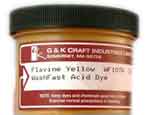I have a white tulle canopy, and I would like to dye it, but how do I go about doing that?
I have a white tulle canopy, and I would like to dye it, but how
do I go about doing that? I'm not sure how to dye tulle, especially something as
big as this. It's a white net canopy, and it's just one that you hook up in the
ceiling with fishbooks. Can anyone tell me how to dye it black?
—ADVERTISEMENT—
Washfast Acid dyes
at Paradise Fibers

Washfast Acid dyes
Also known as Nylomine dyes, excellent for use on nylon. One ounce of dye will dye six pounds of fiber!
at Paradise Fibers

Washfast Acid dyes
Also known as Nylomine dyes, excellent for use on nylon. One ounce of dye will dye six pounds of fiber!
What fiber is it made of? You can buy polyester tulle or nylon tulle, but the way to dye these two kinds of tulle is very different.
Nylon tulle is easier to dye. You can dye it with a kind of dye called acid dyes. The best black acid dye is Lanaset Jet Black. You cannot buy this dye in stores, but will have to mail-order it, for example from Paradise Fibers. It's a very rich, dark, wash-resistant dye. The second-best black dye for nylon is Washfast Acid Jet Black. Like the Lanaset Jet Black, it resists fading and bleeding even when washed in hot water. Other types of acid dye must be washed only in cool to lukewarm water. WashFast Acid Dye Jet Black can be mail-ordered from PRO Chemical & Dye or Paradise Fibers. See my "Sources for Dyeing Supplies Around The World" page.
You can also dye nylon with all-purpose dye, such as Rit, since it, too, contains acid dye, but you will have to use a great many boxes of the dye to get a good dark black. One box is enough for only one-quarter to one-half pound of fabric. The color may be off a little, too, since this is a common complaint for Rit dyes.
In any case, dyeing nylon tulle requires cooking the fabric with the dye and some acid (such as vinegar) at high heat, preferably 185°F. This will require a large cooking pot that you will not reuse for food, since Rit dye, like all textile dyes, will contaminate food. If you try to use acid dye at a lower temperature, you will probably end up with no more than a medium gray color, instead of a dark black. Also, Rit dye will bleed badly in the laundry and fade far, far more quickly than Lanaset or WashFast Acid Dyes. I's easier to find but almost a waste of time.
Dyeing polyester tulle is completely different. Polyester cannot be dyed with acid dye or all-purpose dye. The only dye that works on polyester is called disperse dye. You can mail-order disperse dye from Aljo Dyes in New York or PRO Chemical & Dye in Massachusetts, or if you're in Australia, order from Batik Oetoro. You can also buy it as "iDye Poly" from dye suppliers that sell Jacquard Products dyes. (Don't get the plain "iDye", which works only on natural fibers; only "iDye Poly" will work on polyester.)
Dyeing polyester requires more heat than dyeing nylon. You must boil your polyester at high heat for at least half an hour with the dye. Unlike nylon, it will not work at all at lower temperatures. Extensive boiling is required to get the dye into the polyester, and then only if you have purchased the right dye.
You can also dye nylon with disperse dyes, but the color will not be as dark, and it will wash out more easily, than if you use a good black dye designed for nylon and wool.
It is simpler to just buy black tulle, if you can find it.
(Please help support this web site. Thank you.)
[Portions of this answer were also posted, by me, on Yahoo answers, on November 21, 2008.]
Posted: Thursday - January 01, 2009 at 10:00 PM
Follow this blog on twitter here.
Quick Links
- All About Dyes & Dyeing Top -
- Top of this blog -
- FAQ -
- The Dye Forum -
- How to Tie Dye - How to Batik -
- Books - Toys - Plants -
- Top of this blog -
- FAQ -
- The Dye Forum -
- How to Tie Dye - How to Batik -
- Books - Toys - Plants -
More in this category:
- -
Statistics
Total entries in this blog:
Total entries in this category:
Published On: Aug 29, 2012 02:48 PM
Total entries in this category:
Published On: Aug 29, 2012 02:48 PM